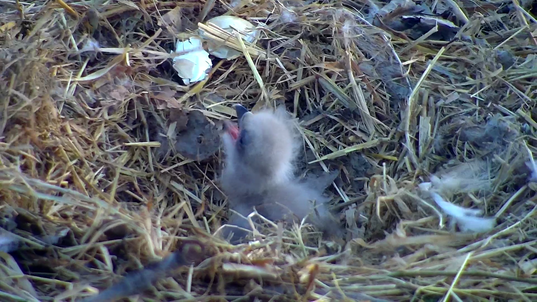|
March 27, 2023
 chick first day photo shoot 03/27/2023
March 27, 2023
On Sunday, March 26 the EagleCam caught just a glimpse of the broken egg and the chick arrived! Both parents sat tightly and didn't leave the bole open for more than a few seconds so we didn't get a clear view of the chick, but we confirmed the hatch at 9pm last night. Thanks to the night vision of the infrared we could see the fuzzy body being rolled around the nest bole. The new microphone even picked up the chick's peeping and the local coyote pack howling! Not to worry - they sound closer than they are and coyotes don't climb trees.
Healthy chick
During incubation, the chick has been absorbing the fluid from the egg sac, so by the time it hatches it is healthy and doesn't need food for the first several hours. This chick has already been fed three times within the first 24 hours! With only one chick to raise, the odds of survival are increased significantly. There will be no sibling rivalry, nor food competition.
The male has been bringing in lots of prey for the the female, and the deliveries increased today to help feed the chick. A fish, a duck and a squirrel were on the menu today. The eagles will leave nothing to waste, setting aside or burying the prey remains in the nest for future consumption. As we've witnessed before, the white-footed mice who also use the nest as a home will consume any tiny left over scraps.
What to expect
Bald eagle chicks are one of the fastest growing species on the planet. Thanks to the work of Gary Bortolotti and Jon M. Gerrard in Saskatchewan in the 1970s and 1980s, we have reliable information on the development of eagle nestlings from hatch to fledge (take flight), including weight and growth of the critical beak, feet, and wing feathers. Beak and feet grow faster than other body parts because they are essential tools for survival and take several weeks to be fully developed. The “gangly” and “clownish” look of young eaglets is largely due to the disproportionate growth of feet and beaks.
Hatched with thin natal down, eaglets gain a thicker second set of down starting a week or so after hatching, and soon thereafter their body (contour) feathers begin to grow. These feathers will become the juvenile (first-year) eagle’s smooth covering by the time it fledges. They take several weeks to reach full length, especially the wing feathers which are not yet fully grown until after fledge. (source: Elfruler.com)
Watchers from over 180 countries
You are part of a large family of dedicated fans around the world! At peak today, there were over 1700 people watching the EagleCam at once! This doesn't account for the many classrooms, waiting rooms and community rooms with multiple students of nature learning about our regal national symbol. We are grateful for every one of you and thrilled to be sharing in the joy of the natural world.
Visit the DNR EagleCam: mndnr.gov/eaglecam
|